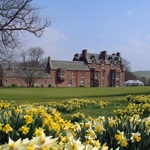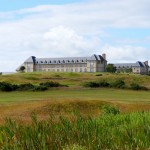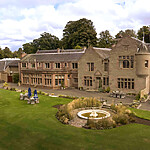Stuart Forster goes whisky tasting at SCHLOSS Roxburghe, an historic manor house on the Scottish borders.
Bottles of single malt whiskies with colours ranging from straw-like to rubyesque stand on the wooden shelves of SCHLOSS Roxburghe’s Bar 1745 next to leather bound books. Long before the manor house at the heart of the 300-acre estate we’re on was converted into an upscale hotel, this high-ceilinged room was the library. Framed portraits of former Dukes of Roxburghe adorn the wall behind the bar.
Three bottles of whisky are on the marble-topped table in front of the four of us gathered for a tasting. Nearest to me is a 12-year-old malt from The GlenAllachie Distillery. It has been finished in a Sauternes cask. Then there’s a tequila cask finished 15-year-old from Deanston and an 18-year-old Bowmore.
Carrie-Anne Jones smiles, introduces herself and explains that over the next hour or so we’ll taste the three whiskies: “As we go through these whiskies, I suggest you take your time. Sip the whiskies. Never rush a whisky. You know, it’s been in the cask for a long time.”

Perhaps we’re eyeing the glasses in front of us little too thirstily because she adds a warning for us not to finish our whisky: “It’s always good to go back and try it again because then you really notice the differences between each whisky. Keep a little bit to go back at the end of the tasting.”
Bringing a bottle of Birkentree birchwater to the table, Carrie-Anne invites us to add a couple of drops to our whiskies after the initial tasting, to experience how it changes our perception of a spirit, perhaps heightening the flavour. “It adds a silky, luxurious feeling. It’s more about the mouth feel than anything else,” she explains, as we ready ourselves for the tasting.

“What I’d like to do to start with is just to nose the whisky. I think it’s always really important to take a couple of minutes to just sit and smell the whisky before you actually taste it because you’re opening up all your senses and basically you’re getting your body ready for the whisky…That sounds very dramatic,” she adds and chuckles.
We hear that the 12-year-old whisky was matured in a bourbon cask that imparts a creaminess and vanilla tones. The French dessert wine cask that it was finished in adds a rounded sweetness and we pick out aromas of apple.
“So we’ve had a smell of the whisky. Let’s have a sip. It’s always good if you can to hold the whisky your mouth for a moment to let your tastebuds get used to it,” says our tasting guide.
“For this whisky, I find initially you get a lot of apple notes but then as you drink it’s more creamy and you get a lot of peach and apricot flavors…I discovered this whisky at the start of this summer and, for me, it is the summer in a bottle. I just absolutely love it,” adds Carrie-Anne with infectious enthusiasm.
It’s a product of Speyside, one of Scotland’s five whisky-producing regions. We hear how whiskies from Speyside tend to have fruity, spicy and quite sweet characteristics.
Those from the Highlands are diverse while whiskies from Campbelltown are slightly oily, salty and have a thick consistency. Islay whiskies tend to be peaty while those from the resurgent Lowlands region tend to be mellow, grassy and fragrant.
Carrie-Anne explains that the widespread use of cask finishes is making it increasingly difficult for people to pinpoint where whiskies originate. Several Speyside whiskies, including the Benriach Distillery, now feature peaty flavours.
Deanston Distillery is from the Highlands and its 15-year-old whisky with a tequila cask finish has an earthy nose with a hint of the Mexican spirit’s aroma. Cask strength, it is 52.5 per cent alcohol by volume.
We chat about distillery tours as we smell the whisky and Carrie-Anne recommends Bunnahabhain’s warehouse nine tour.

A couple of the people at the table admit to being novice whisky drinkers and Carrie-Anne explains the whisky that evaporates as it matures is known as the angel’s share. Conversely, the liquid that soaks into the wood of barrels during maturation is know as the devil’s share. Despite those losses, wood barrels impart colour and character in the whisky.
As we sniff, sip and savour we discuss everything from the number of times that Scottish distillers typically use barrels. While chatting, Carrie-Anne recommends Monkey’s Shoulder for mixing whisky-based cocktails and McLean’s Nose, a blended whisky, for smoky Old Fashioneds.
Moving on to the 18-year-old Bowmore Carrie-Anne says: “For me, this whisky is a great representation of Scottish whisky in general. If I was to pick a bottle that represented Scottish whisky, it would be Bowmore because Scottish whisky is known for the peat. That’s the thing that makes it different from all other whiskies around the world – the peat. This has the peat but it’s very mellow.”
“You get lots of lovely sherry flavours there. And I find it reminds me a little bit – on the palette more than on the nose – of Dairy Milk fruit and nut chocolate. I find it really chocolatey in the palette but smoky,” she enthuses.
“This whisky in particular is almost like a representation of this room…it’s got that kind of woodiness, leatheriness, kind of like the gentleman or a lady smoking a cigar,” says Carrie-Anne gesturing around the library.
I catch myself gazing around the room then continue to sip the whiskies. The tasting has proved enjoyable and as it ends we thank our hostess for her expert insights before wandering back to our SCHLOSS Roxburghe self-catering cottages.
Tell me more about SCHLOSS Roxburghe
SCHLOSS Roxburghe is at Heiton, near Kelso, in the Scottish Borders. It has 20 bedrooms and suites in the historic manor house plus a further 58 guestrooms in its Estate House extension, which was completed in 2022. In 2024, 51 self-catering cottages were opened on the 300-acre estate.
Low-season rates for a two-bedroom cottage at SCHLOSS Roxburghe start at £352 a night, one bedroom cottages are from £285 a night and king bed courtyard rooms start at £153 a night. Hotel rooms include breakfast and spa access. Cottages receive £25 credit per cottage daily for use in the Estate Market and guests can buy discounted spa day passes for access to the spa. Day spa packages start at £70 per person.
A range of country sports are offered at SCHLOSS Roxburghe, including fly fishing on the estate’s trout loch and its 2.5-mile stretch of the River Teviot. Archery lesson are £60 per hour for one person aged 12 and up, £100 per hour for two archers and £150 per hour for three archers. Clay pigeon shooting tuition costs £100 per hour, including 50 cartridges, for people aged 12 and up. Group instruction is available, for groups of eight or more people, at a cost of £95 per person.
Sunlaws tasting menu is £95 per person plus £55 per person for the option of the wine pairing.
Whisky tastings at SCHLOSS Roxburghe are priced at £50 for a standard tasting or £100 for a premium tasting. Reservations can be made by calling 01573 450331 or E: info@schlossroxburghe.com






